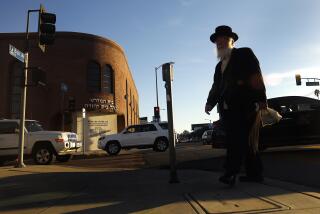In Terms of Tradition, Shofar Is a Horn of Plenty
- Share via
THOUSAND OAKS — When David Nadel stands before his congregation to blow the shofar during Rosh Hashana services today, he will be counting on familiar sights.
A stir among congregants restless after hours of prayer. The eyes of children opened wide in wonder at his long, final blast on the ram’s horn. And the faces of the oldest in the crowd lighting up with memories of Jewish New Years past.
“When I’m blowing the shofar, it’s like I’m keeping my finger on the pulse of Judaism,” said Nadel, a member of Thousand Oaks’ Temple Adat Elohim. “I get to see how people respond.”
Nadel, 44, is among the select few of Ventura County’s Jewish community who will sound the simple, roughhewn instrument, a centuries-old ritual designed to rouse the consciences of worshipers during the most sacred days on the Jewish calendar.
And for local baale tekiah, as they are known in Hebrew, blowing the shofar is not a task taken lightly.
“The sound of the shofar connects one to [thousands] of years of history,” said Peter Jaffe, shofar blower and longtime member at Temple Beth Torah in Ventura. “It’s an emotional thing. You don’t hear it, you feel it.”
Ronald Goldstein said he has been practicing every day to prepare his lungs for what can be a difficult job. On Sunday, he and his son, Jeremy, will blow their shofars 100 times during Rosh Hashana services at Temple Etz Chaim in Thousand Oaks. The congregation, affiliated with the Conservative branch of Judaism, does not permit the blowing of shofars on Saturdays, the Jewish Sabbath.
“You have to do it well,” said Goldstein, an optometrist. “It’s really the climax of the day.”
In ancient times, the piercing bellows of the rams’ horns were used as communication devices during times of war. In the Bible, it is said that Joshua fought the battle of Jericho with a troop of shofar blowers whose blasts helped bring the walls around the city tumbling down.
But since the time of the Jewish Temple 3,000 years ago, shofars have evolved into a more positive use, stimulating introspection and repentance during Rosh Hashana and Yom Kippur. The Day of Atonement, or Yom Kippur, this year will fall on Oct. 9.
“It’s a wake-up call to humanity occupied with the transient, material parts of the world,” said Yakov Latowicz, rabbi at Chabad of Ventura, a synagogue and community center. “It’s a call to look into the soul and examine why we are here.”
Latowicz plans to blow the shofar Sunday, unless a brave, big-lunged substitute shows up at services, he said.
Jaffe, a trombone player in the Ventura County Concert Band and Seniors of Note, a senior citizen dance band, said he is nervous about blowing the shofar before the 800 congregants at Temple Beth Torah.
“I think every artist gets nervous before they perform,” said Jaffe, 66, the former owner of a chain of camera stores in the west county. “If you’re not nervous, you don’t do a good job.”
Three years ago, he was asked by Rabbi Lisa Hochberg-Miller to take over the job because of his musical experience.
Still, he said, his trombone playing helps only so much when it comes to blowing the hollowed-out ram’s horn.
“The shofar is a difficult instrument to play,” he said. “Your lips get tired quickly.”
Goldstein started blowing the shofar at Temple Etz Chaim’s High Holiday services 39 years ago, when he and his wife, Sybil, moved to the community. At that time, the congregation’s membership was small and services were held at a church.
Years later, his three sons joined him on stage, and the quartet became a holiday tradition until the two youngest sons, Evan and Harland, moved out of the county.
Now, Jeremy, 36, stands alone with this father before 1,500 congregants, blowing a three-foot shofar he picked up in Israel 10 years ago.
“The shofar blowing is the highlight of the service for people,” said Jeremy, the owner of a pool-cleaning business. “They don’t want to miss it.”
Nadel, an accountant, said he had to audition for the part when he and his wife, Ellen, moved to Thousand Oaks from the San Fernando Valley three years ago, even though he has been blowing a shofar since he was 12.
Nadel, a one-time professional trumpet player, said his first shofar gig was on a High Holiday television special in 1969 featuring the late actor Edward G. Robinson as host. The father of two said he prides himself on the refined sounds he can make, using his trumpet skills.
Nadel said officers at the temple were skeptical about his ability until they heard him.
“They just sat there sort of dumbfounded,” he said.
Now, without any stage fright, Nadel said he is eagerly awaiting the climax of today’s shofar service, when he blows the tekiah gadolah, or “big blast,” which he can hold for 40 seconds.
“I’ll look down and people will start to make all these noises and they’ll start gasping for air for me when my face changes colors,” said Nadel. “And I’ll just keep blowing. It’s really cool.”
More to Read
Sign up for Essential California
The most important California stories and recommendations in your inbox every morning.
You may occasionally receive promotional content from the Los Angeles Times.











